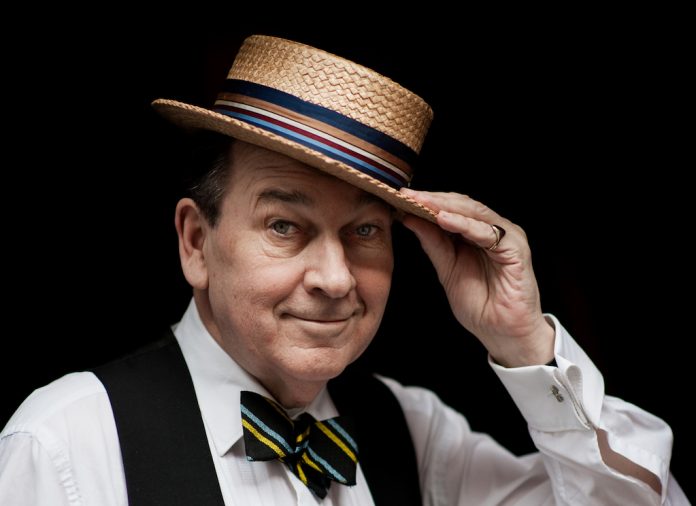I first saw Paul Ryan live on stage in the last decade of the 20th century. If not quite the quarter of a century that that implies then certainly a good 20 years and change. The stage was on the first floor of the Institute Français in South Kensington, which had recently come to the end of its days as a legitimate theatre and been reborn as Ciné Lumière, with a brief to promote French films in London.
One of the ways Ciné Lumière went about marketing was to punctuate screenings with what used to be called “personal appearances”, i.e., bringing over from Paris the creative personnel – writers, directors, actors, l’equipe, often (Valerie Lemercier, Guillaume Canet, Agnes Jaoui) all three in one person – of a current film whilst simultaneously bringing from Notting Hill Paul Ryan to introduce, interview, and interpret for the benefit of non-French speakers in the audience, not least myself.
I seldom missed one of these events and fell into the habit of chatting briefly with Paul about French movies before or after the gig and until comparatively recently, some seven or eight years ago, I had no idea of his other life. It also involves interpreting, but this time of the Great American Songbook in small venues in and around the West End.
This meant that when I met Paul earlier this month for Jazz Journal I was already armed with one question which I parlayed into three: (1) was he already singing at the time I knew him first; (2) if so, which came first; and (3) did he prefer one over the other? If he does this right the interviewer can then sit back as the interviewee, fully primed, springs into full reminiscence and, in an anglicised version of Proust’s madeleine, takes the interviewer from his first Farley’s rusk to his last pie à la mode. Boy, did this interviewer get it right, because four hours and three notebooks later we were still knee deep in conversation and Birnham Wood was only a little more than halfway to Dunsinane.
He caught my opening question in mid-air and tossed it back with a little spin on it. “Yes, I was already singing – and dancing when we first met. I was singing and dancing prior to my first gig at Ciné Lumière, and yes, I do prefer singing”.
The Paul Ryan I met back in the 90s was already urbanity personified, polished until you could see your face in his boutonnière. The Ryans were an Irish family settled in a depressed area of Cardiff and Paul’s mother came from a family with three generations of a theatrical/music hall involvement. Paul says: “That’s how I fell into singing, along with my cousin John Sloman who was lead singer with Uriah Heap.
“I arrived in London in 1974, knowing no one and with no contacts, and somehow, without really trying, I lucked into the world of show business”. He had no formal training in any aspect of show business – something he still lacks to this day. Rather than move into a conventional flat/bed-sit, he went almost immediately into the heart of a charmed circle where, with the unsolicited help of a benign fate he proceeded to reinvent himself as singer, dancer, actor, author, journalist, lecturer and presenter.
Wherever you live in the UK you may well have read Mr. Ryan’s pieces in The Guardian, Sight and Sound, The Independent, Art Quarterly, The Times, The Sunday Times or The Irish Times, and if your DVD collection includes titles such as Walkabout, Don’t Look Now, Hotel Du Nord, The Beat That My Heart Skipped, La Grande Illusion, The Wages Of Fear, This Sporting Life or Les Enfants Du Paradis then you may have checked out his on-screen narration and/or interviews with the directors. But unless you live in or near London you may have missed his cabaret appearances at the Pheasantry, Ronnie Scott’s, Pizza Express, Crazy Coqs and the Hippodrome Casino.
Although he still occasionally works with a trio or quartet his accompaniment of choice is solo piano and he is particularly keen to give full credit to both Kenny Clayton (with whom he recorded a CD released in 2018) and Jamie Safir, both of whom can and do swing. Like the majority of performers working in his field he has an extensive working knowledge of The Great American Songbook and it’s a rare evening that doesn’t draw heavily on the catalogues of Cole Porter, Rodgers and Hart, Gershwin, Arlen, Carmichael and Mercer, each selection finessed with an anecdote or two surrounding the song itself and/or the composer. Should you feel sated with the cream of GAS you’ll find the big names leavened with contributions from the lesser-spotted songwriter such as Burton Lane, Willard Robison, Matt Dennis or Bobby Troup.
In sum, an evening spent in the company of Paul Ryan and the Great American Songbook is an evening well spent.
















